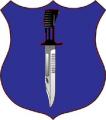For a platoon, company, or even battalion commander, an enemy weakness is likely to be a physical gap in the enemy's position. How can he find the gap? Through what we call "reconnaissance pull" or "recon-pull."
Currently, most Marine units use the opposite of recon-pull tactics, called "command push." The axis of advance is chosen before the operation begins, and it is seldom altered. The commander pushes however many forces are needed down that axis to make the attack successful. Of course, this often results in throwing strength against strength. With recon-pull, the axis of advance is determined by the results of reconaissance rather than being fixed by command from above, and it shifts in response to what the recon finds.
An exapmle of one type of attack may be helpful in understanding this. Your forward element is a reconnaissance screen. Its job is to look for surfaces and gaps.
When it finds a gap, it goes through, and calls other forces to follow. [my emphasis--EMW] If the gap seems to be promising, the unit commander commits more forces through it. Some of the forces widen the gap and roll out behind the enemy position that has been penetrated, collapsing it from the rear. Meanwhile, the reconnaissance screen continues to move forward, always seeking the path of least resistance. The recon pulls the main force around the enemy surfaces and ever more deeply into the enemy position.
Recon-pull requires a different type of reconnaissance from what Marines are used to. Today, most recon forces are committed deep, along the axis of advance chosen for the "command push." There is no reconnaissance screen. For recon-pull, you must have a recon screen. It is different from a security screen, in that it orients on the enemy, not on your own unit. It must be strong. Indeed, all your forward forces must be a part of it. In maneuver warfare, recon is everyone's responsibility.














Bookmarks